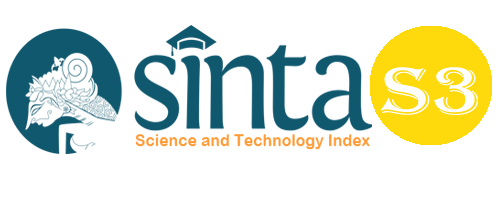Evaluation of Follow-Up Monitoring Information Systems Using Hot Fit Models (Case Study in Majene District Inspectorate, West Sulawesi)
Abstract
This study evaluated the effectiveness of the Follow-up Monitoring Information System (SIPTL) of the Audit Board of the Republic of Indonesia (BPK RI) based on the HOT Fit Model. Evaluation is focused on external SIPTL or from the auditee side. This research is a qualitative research with a case study approach and the object of the research is the Inspectorate of Majene Regency, West Sulawesi. Evaluation is carried out on human aspects (system use and user satisfaction), organization (organizational structure), and technology (quality of systems, information, and services). In the human aspect or Human Resources (HR) management, it shows the suitability of the field of experience, knowledge, and competence. In the organizational aspect, controlling access rights is very good in the form of passwords on each admin and SIPTL inputer. In the technological aspect, the speed of access between pages and the addition of features to the SIPTL application are very easy. Thus, in general, the application of external SIPTL to the Majene District Inspectorate has been effective based on the HOT Fit Model. The disadvantages of SIPTL today are the absence of regular training of users, communication with users that has not run optimally, the absence of regular password changes, and the absence of regular application updates. Further research is recommended to evaluate internal SIPTL, namely from the side of the BPK RI as a user and the addition of research objects as a comparison analysis.
Keywords
Full Text:
PDFReferences
Antonius Alijoyo, B. W. (2021). Structured or Semi-structured interviews Wawancara Terstruktur atau Semi-terstruktur. CRMS.
Ayuardini, M. (2019). Implementasi Metode Hot Fit pada Evaluasi Tingkat Kesuksesan Sistem Pengisian KRS Terkomputerisasi. Faktor Exacta 12, 122-131.
BPK. (2017). Peraturan BPK Nomor 2 Tahun 2017 tentang Pemantauan Pelaksanaan Tindak lanjut Rekomendasi Hasil Pemeriksaan BPK.
BPK. (2021). Ikhtisar Hasil Pemeriksaan Semester (IHPS) I Tahun 2021.
Bupati. (2021). Surat Keputusan Bupati Majene Nomor 205/HK/KEP-BUP/II/2021 tentang Tenaga Operasional Pada Inspektorat Kabupaten Majene Tahun Anggaran 2021.
Bupati. (2021). Surat Keputusan Bupati Majene Nomor 404/KEP-BUP/III/2021 tentang Pembentukan Tim Tindak Lanjut Laporan Hasil Pemeriksaan Badan Pemeriksaan Keuangan Republik Indonesia dan Aparat Pengawasan Intern Pemerintah Kabupaten Majene Tahun Anggaran 2021.
C Marshall, G. B. (2011). Designing qualitative research. thousand oaks, calif london: Sage Publications.
Creswell, J. W. (2015). Penelitian Kualitatif dan Desain Riset. Yogyakarta: Pustaka Pelajar.
Fatmawati, E. (2015). TECHNOLOGY ACCEPTANCE MODEL (TAM) Untuk Menganalisis Penerimaan Terhadap Sistem Informasi Perpustakaan. Jurnal Iqra, Volume 09 No.01.
Hartanto, D. (2020). Sociology Review of Social Phenomenon, Social Rules and Social Technology. Budapest International Research and Critics Institute-Journal (BIRCI-Journal) Vol 3, (2): 1175-1184.
Hasibuan. (2011). Manajemen Sumber Daya Manusia. Jakarta: PT Bumi Askara.
Hera Adrianti, H. (2018). Pengaruh Faktor End User Computing Satisfaction (EUCS) Terhadap Manfaat Nyata Pengguna Sistem Informasi Elektronik (E-Puskesmas) di Puskesmas Sawah Besar Jakarta. Indonesian of Health Information Management Journal, Vol.6 No 2.
IAI. (2015). Modul CA Sistem Informasi dan Pengendalian Internal.
Ilma Soraya, W. R. (2020). Pengujian Model Hot Fit Pada Sistem Informasi Manajemen Obat Di Instalasi Farmasi RSGMP UNSOED Purwokerto. Fakultas Ekonomi dan Bisnis, Universitas Jenderal Soedirman.
Indrajit. (2001). Analisis dan Perancangan Sistem Berorientasi Object. Bandung: Informatika.
Lubis, S. H. (2017). Evaluasi Sistem Informasi Perpustakaan IAIN Padangsidimpuan Menggunakan HOT FIT Model.
Lusiana, D. (2020). Pengaruh Human Organization Technology (Hot) Fit Model Terhadap Evaluasi Sistem Informasi Akademik Dosen.
Marlizar, et.al. (2021). Effect of Service Quality and Use of E-Service Technology on Customer Loyalty: A Case Study of Maxim in Aceh. Budapest International Research and Critics Institute-Journal (BIRCI-Journal) Vol 4, (4): 8002-8016.
Marshall B. Romney, P. J. (2020). Accounting Information Systems, 15th Global Edition.
Moleong, L. J. (2005). Metodologi Penelitian Kualitatif. Bandung: Remaja Rosdakarya.
Octaviani, D. W. (2018). Evaluasi Fitness Function Aplikasi PBB Online Menggunakan Pendekatan HOT FIT Model Studi Empiris: Badan Pengelolaan Keuangan dan Pendapatan Daerah - Pemerintah Kota Surabaya.
Prabowo, G. I. (2019). Evaluasi Keberhasilan Implementasi Sistem Informasi E-Donasi Dengan Metode HOT-FIT.
Putra, A. D. (2020). Evaluasi Sistem Informasi Manajemen Rumah Sakit (SIMRS) Dengan Metode HOT FIT Di RSUD Andi Makkasau Kota ParePare. Jurnal Ilmiah Manusia dan Kesehatan, Vol. 1, No.1.
Rusdiana, M. I. (2014). Sistem Informasi Manajemen. Bandung: PUSTAKA SETIA.
Siregar, K. R. (2011). Kajian Mengenai Penerimaan Teknologi dan Informasi Menggunakan Technology Acceptance Model (TAM). Telkom Institute of Management.
Sugiyono. (2005). Memahami Penelitian Kualitatif. Bandung: CV. Alfabeta.
Sulistyanto, N. B. (2018). Evaluasi Aplikasi ST/SKI Di BPKP DKI Jakarta Dengan Pendekatan HOT-FIT Model. Ekuitas: Jurnal Ekonomi dan Keuangan Akreditasi No.80/DIKTI/Kep/2012, volume 2, Nomor 4 Hal 512-530.
Wahyuningsih, S. (2013). Metode Penelitian Studi Kasus (Konsep, Teori Pendekatan Psikologi Komunikasi dan Contoh Penelitiannya). Madura: UTM Press.
Widyastuti, H. N. (2020). Evaluasi Sistem Elektronik Rekam Medis Di Rumah Sakit Primasatya Husada Citra Surabaya. J-REMI: Jurnal Rekam Medik Dan Informasi Kesehatan, Vol. 1 No. 3.
Yusof, M. K. (2008). An Evaluation framework for Health Information Systems: human, organization and technology-fit factors (HOT-fit). International Journal of Medical Informatics, 386-398.
DOI: https://doi.org/10.33258/birci.v5i3.6081
Article Metrics
Abstract view : 79 timesPDF - 38 times
Refbacks
- There are currently no refbacks.

This work is licensed under a Creative Commons Attribution-ShareAlike 4.0 International License.

This work is licensed under a Creative Commons Attribution-ShareAlike 4.0 International License.

_.gif)

















_.gif)



